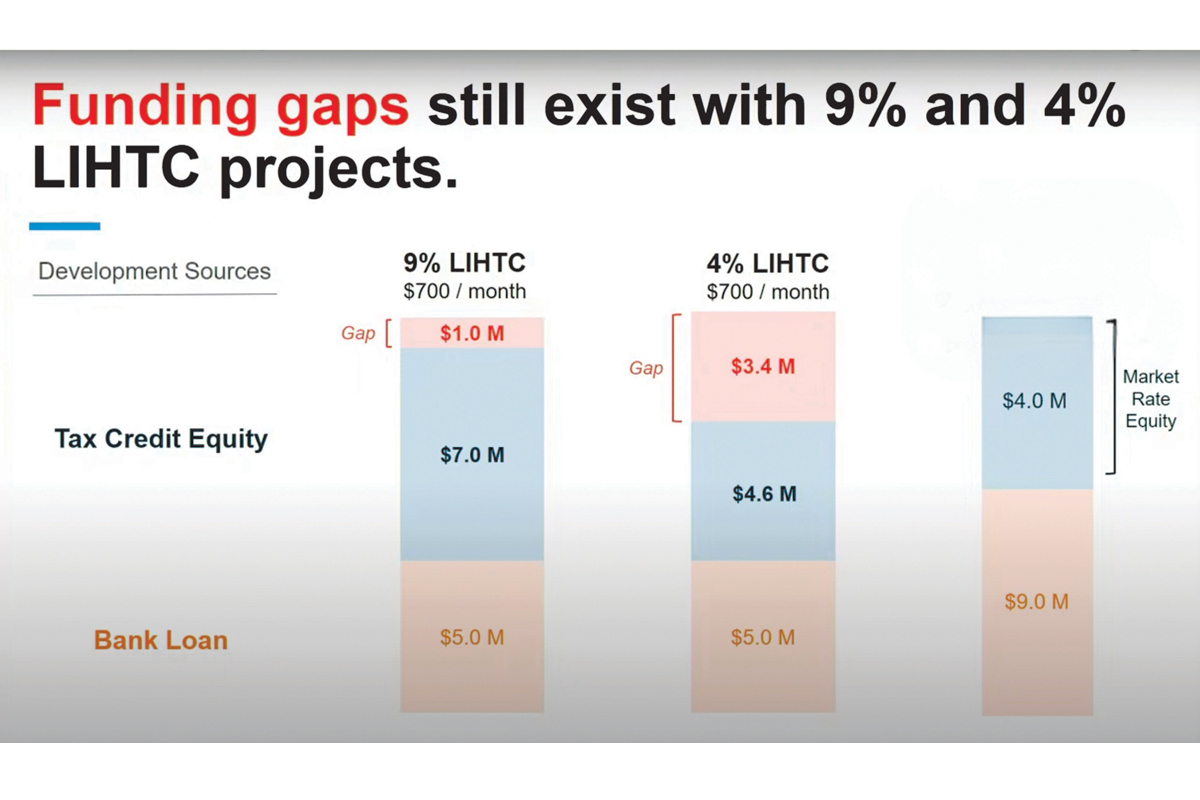Jackson explores solutions to housing crisis
 Funding gaps for affordable housing persist even with Low-Income Housing Tax Credits. DFI photo
Funding gaps for affordable housing persist even with Low-Income Housing Tax Credits. DFI photo
The Development Finance Initiative has continued to work on feasibility analyses for affordable housing in Jackson County since its housing needs assessment presented in February showed a dire need for affordable housing.
And while there are no quick fixes to the behemoth issue currently plaguing Western North Carolina, DFI is able to offer incremental, long-term steps for Jackson County’s future.
“Solving the housing crisis you have today is not going to happen overnight, and it’s not going to happen with one or two developments,” said Development Finance Initiative Project Manager Sarah VanLear. “It’s a long-term endeavor to pursue the housing priorities that you have.”
The Development Finance Initiative is a program of UNC’s School of Government that works with local governments across the state to meet housing needs. The group is identifying sites that can meet the affordable housing needs specific to Jackson County to conduct high-level site and financial feasibility analysis.
The DFI is undergoing phase one of the project, a site identification process to identify affordable housing development opportunities. This involves stakeholder engagement, a housing needs (market) assessment, site suitability analysis and high-level site and financial feasibility analysis.
“We brought the housing needs assessment to you in February,” said VanLear. “Since then, we’ve been doing our site identification and suitability analyses and then on select sites doing a high-level site and financial feasibility, really to take a look at what are the opportunities and constraints on select sites and then financially what kind of development costs, the potential private sources and the estimated financial gap to be considered to bring about a project on that site.”
Related Items
The DFI has interviewed over 25 stakeholders, including Dogwood Health Trust, Jackson County Chamber of Commerce, Jackson County Planning Board, Mountain Projects, Southwestern Commission Council of Governments, Southwestern NC HOME Consortium, Nantahala Health Foundation, Tuckaseegee Water and Sewer Authority, Towns of Dillsboro and Sylva and Western Carolina University.
There is overwhelming agreement among stakeholders that the limited housing stock has created pressure for low- to middle-income households for single-person, family and senior households alike. The range of needs means that there is a variety of housing types required to address the problem, including rental and homeownership opportunities, high density apartments and low-density single-family homes.
“What has really struck us is the consistent support for affordable housing development across every sector that we’ve talked to,” said VanLear. “So public stakeholders, nonprofit, education and private stakeholders. Everyone is feeling this pressure, and everyone is behind affordable housing development to help meet the needs of clients, colleagues, friends and the people they know that are in their personal and professional lives.”
Right now, there are over 2,500 low- to moderate-income households in Jackson County who have housing needs. More than 1,200 of those have severe housing needs, categorized by those that spend more than 50% of their income on housing-related expenses, and/or living in low-quality living conditions.
Housing supply in the county is constrained by seasonal-use units, low quality or off-market sites and student housing.
“These constraints are all acting at once in the same place which is creating a housing market that is really limited and very competitive and leading to low vacancy rates and rising prices,” VanLear said.

Debt for housing projects tend to be proportional with the expected payment per housing unit. DFI photoDebt for housing projects tend to be proportional with the expected payment per housing unit. DFI photo
On average, the county’s largest municipalities have a vacancy rate below 1%, when typically, a 7% vacancy rate is healthy. Available rentals are affordable to households earning more than $80,000 a year or more. Meanwhile, the average median income for a four-person household in the county is approximately $74,000 a year.
Low-to-moderate-income households are defined as those that make 80% or less of the area median income. This means that a four-person household in Jackson County is considered low-to-moderate income, or LMI, if it is making $58,000 a year or below. About 50% of LMI households in Jackson County make 50% or less of the area median income, or AMI, or under $36,000 a year.
“Households need an annual income of over $163,000 to purchase the average home on the market today,” said VanLear. “That’s 220% of the area median income. I know this has been a consistent problem through the years but in 2020, three and a half years ago, you needed about $60,000 as a household to buy the average home on the market at that time.”
That $60,000 price tag was about 80% of the area median income.
“So, in a really short time period, home ownership has become inaccessible to many of your residents,” said VanLear.
Mobile homes make up a third of the naturally occurring affordable housing in the county. However, more than 300 of those units are in a flood zone.
DFI has explored sites for both multi-family rental opportunities as well as single-family homeownership opportunities. The DFI looked within municipal boundaries and water/ sewer service areas; considered slope, flood zones and general buildability; looked at all public owned sites to see if there was anything already in the county’s control that would be an opportunity for affordable housing, and looked at other sites that had the potential for site control in the future.
In looking at housing opportunities, DFI considers financial gaps that inhibit development. Financing institutions consider the amount that a rental unit will be able to charge for rent, or a developer will be able to charge for homeownership, when determining how much debt they will give an entity to build a housing development.
Market rate housing can expect to charge somewhere close to $2,500 for rent per unit per month following construction, whereas affordable housing developments can expect to charge closer to $700.
“The debt that developers are able to access is limited because they don’t have as much net operating income that they can count on to service that debt. So, there’s a pretty direct correlation,” said VanLear. “In both cases, there’s a gap. Most developers will fill that gap with equity. Folks are willing to invest in those properties based on the potential returns they might get.”
“In the case of affordable housing, that gap still persists, because the equity that you’re able to achieve is also based on that rent you’re able to get, which is a limiting factor,” VanLear added.
One of the options for covering that gap that persists with affordable housing development is the Low-Income Housing Tax Credit. There are two versions of that program — 9% and 4% tax credits.

Developers are less likely to risk equity for affordable housing projects. DFI photo
“That’s a big factor in filling that gap that exists when you’re creating that affordable housing development,” VanLear said.
In the cases of site feasibility DFI is investigating in Jackson County, it has already incorporated accessing LIHTC in its analysis.
For multifamily sites DFI looked at two-acre sites and larger, as well as the eligibility requirements for the 4% and 9% Low-Income Housing Tax Credit awards. For single family sites DFI looked at smaller sites, one acre and under.
“We looked mainly at large property owners, and we took that lens because if you’re thinking about the sort of infill development, it’s potentially easier to work with one owner, versus looking at multiple sites with multiple owners,” said VanLear. “That complexity can increase quite immediately when you’re working across a number of different stakeholders.”
DFI also looked at multi-year tax delinquent developed and undeveloped properties to see if there were underutilized parcels that the county could think about putting back into service.
In their work, DFI found sites with a maximum capability of 90 units and estimated development cost of $25 million, with an estimated financial gap of $12 million. Site scenarios had a minimum capability of 60 units with an estimated development cost of $16 million and an estimated financial gap of $1 million.
For single family sites, the idea is that the county would gain site control at fair market value and enter into an agreement with a development partner in order to construct that affordable house.
“We’ve put some kind of baselines in place, we’ve assumed a half-acre lot, we’ve assumed a baseline of an affordable house for a household making 60% of the area median income,” said VanLear. “As you can imagine these numbers change depending on the lot size and household income, there’s some dynamic factors there.”
But baseline estimates show the county investing $25,000 up front into a lot, based on undeveloped plan sales currently in the area. Then, the developer would build a house for just under $300,000. To cover the cost created by allowing residents to purchase that house at an affordable price, there would be a gap of $170,000, bringing the total estimated gap on the single-family affordable housing property to just under $200,000.
“One of the things I want to mention here is that these are baseline numbers, there are a number of factors that could affect that gap,” said VanLear. “There are federal programs, for example, that lower the overall construction costs. There are other programs that enable equity that the household can actually access, giving them an opportunity to afford more of a mortgage so they can pay a little bit more and that gap would potentially reduce.”
Moving forward, key considerations for suitable sites will take into consideration that Jackson County and its municipalities own less than 1% of land, and approximately 50% of that land is in use. Nearly half of publicly owned parcels intersect with a floodplain.
More than a third of multi-year tax delinquent properties are likely heirs or estate properties.
“For those properties that are undeveloped and unoccupied there may be an opportunity to utilize currently underutilized properties in the county,” said VanLear.
After looking at large landowners in the county, DFI does not think those represent near-term development opportunities either because those landowners are big institutions like Western Carolina University or the Forest Service, or they’re in parts of the county that are largely resort and recreational use areas of the county or near or on nature preserves that are not close to amenities.
Next steps are site-specific predevelopment scopes. That involves identifying sites on which to pursue affordable housing developments, approaching property owners regarding an option to purchase and beginning phase two feasibility analyses to determine development programs and solicit development properties.
Commission Chairman Mark Letson asked VanLear, “of all the properties you’ve looked at, how many do you think are feasible for next steps, for phase two?”
VanLear said there are three properties they think are feasible for phase two.
“We think there are multiple options for the county to consider,” said VanLear.













